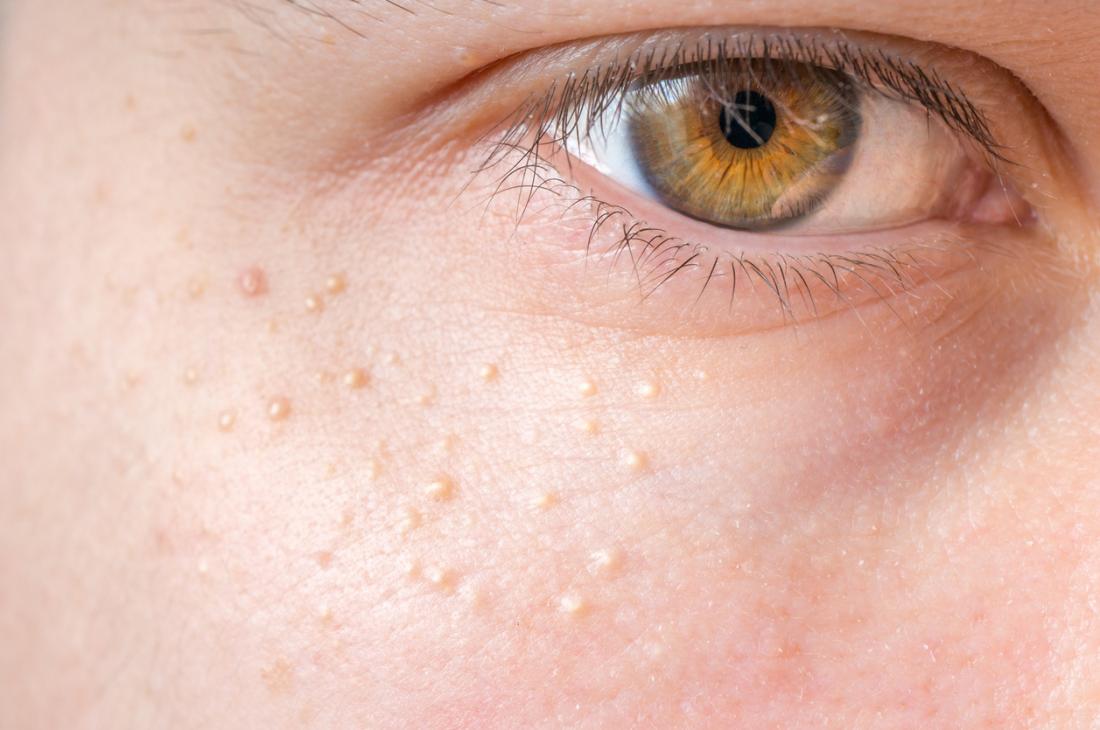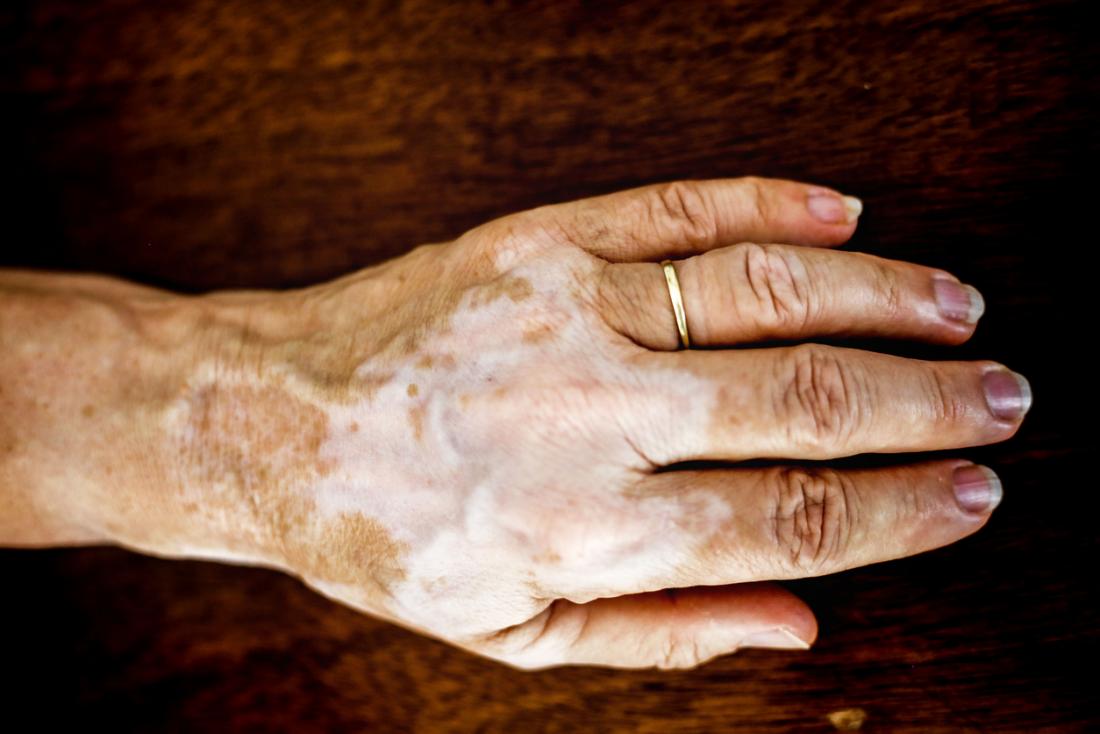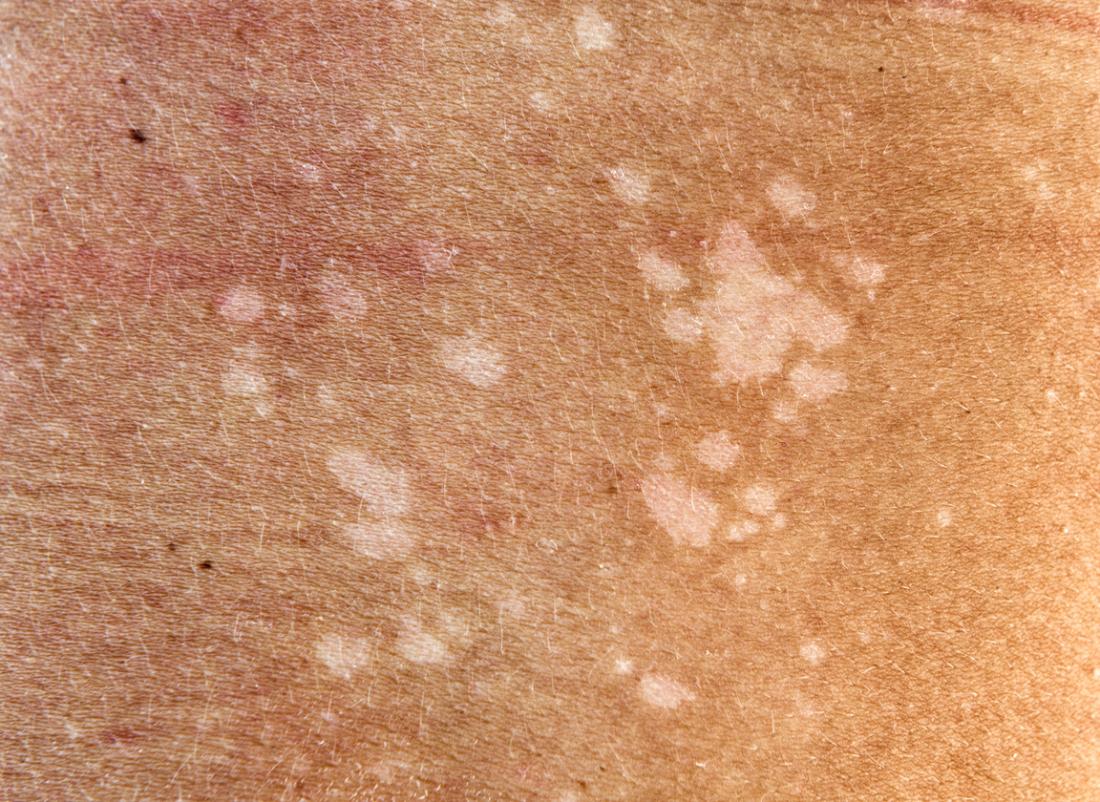Many people experience white spots on their face at some point during their lives. The affected areas may just be on the face, or they may appear on the chest or arms as well. White spots can take different forms. They could be patches of discoloration on the face or small hard bumps.
In this article, we will examine the five main possible causes of white spots on the face. Read on for more about them, what causes them, and treatment options.
1. Milia

Milia may occur in people of all ages and are often mistaken for whiteheads.
Milia are small round, hard, white bumps on the face that are often mistaken for whiteheads. They develop when keratin — a protein found in the upper layer of skin — and other dead skin cells components get trapped below the skin surface.
The most common areas for milia to appear are around the eyes, the cheeks, and on the nose.
Milia can occur at all ages in both men and women. They occur most often in very young babies, and the condition is also called milk spots.
Causes
Milia can be triggered by an allergic reaction to harsh products, by face cream that is irritating, and by sun damage.
Treatment
Milia usually get better without treatment within a few weeks. Dermatologists recommend not squeezing or piercing the bumps at home.
A change in face cream or other products that might have caused a reaction may help. A good skincare routine, including dead skin removal with exfoliants and wearing sun protection cream, is also advisable for adults.
If the condition does not improve on its own, a doctor or dermatologist can treat milia in a variety of ways:
- Lancing. The doctor or dermatologist will use a medical-grade fine needle to extract the keratin.
- Applying a retinoid cream. People can use this on their face but not around their eyes.
- Microdermabrasion. This is a procedure which removes the uppermost layers of the affected area.
- Skin peel. A treatment that removes the top layer of skin and can be used to remove milia.
Milia is not a dangerous condition and causes no discomfort, pain, or stinging.
If the white bumps do not disappear on their own, or if a person finds them unsightly, talk to a doctor about having them removed.
2. Pityriasis alba
Pityriasis alba is thought to be a type of eczema. It appears as pale pink or red, scaly areas on the skin, which clear to smooth white (hypopigmented) patches.
There can be as many as 20 patches, often on the face and arms. Pityriasis alba is more noticeable on people with dark skin or after sun exposure.
The condition is mostly found in children and adolescents, with 5 percent of children worldwide developing the condition at some point.
Causes
Doctors do not know what causes pityriasis alba.
Treatment
The patches usually disappear within a few months but can last up to a few years. There is no specific treatment for pityriasis alba, but a doctor may treat any symptoms of itching or discomfort with a steroid or non-steroid cream.
If the patches start to itch or feel uncomfortably dry, a person should consult a doctor.
3. Vitiligo

Vitiligo may occur in people of all skin colors and might be inherited.
Vitiligo appears as patches of skin that have lost their color pigment. It can occur anywhere on the body, including the face. It affects around 1 percent of people worldwide.
The white patches may start small and sometimes remain this way, but they can also slowly increase until the patch covers a large part of the body. Occasionally, some color may return to the affected area but rarely completely.
Vitiligo can occur at any age, but around half of the people with the condition develop it before their 20s.
Causes
Anyone can get vitiligo, though the chances increase somewhat if someone else in the family has it. The factor of inheritance has yet to be fully understood, so the children of a person who has vitiligo will not necessarily develop it as well.
Vitiligo occurs in people of all skin colors, but it is most noticeable on black skin. It is not contagious.
Skin cells make a pigment called melanin, which gives the skin its color. Some scientists believe that the skin affected by vitiligo develops when the body forms an antibody against melanin and destroys it.
Treatment
There are several possible treatments for vitiligo. The type offered depends on the severity of the condition.
People with vitiligo should wear sunscreen at all times and cover-up in the sun as the affected skin will burn more easily.
If a person wants, they can use colored skin creams to hide areas of vitiligo, and a doctor will be able to recommend the best creams available.
The doctor may also recommend anti-inflammatory creams, such as a higher strength corticosteroid, to help restore missing pigment.
Long-term use of corticosteroids, however, can bring undesirable side effects, such as thinning of the skin, so doctors may prescribe other types of anti-inflammatory creams.
Artificial ultraviolet (UV) light treatment or phototherapy may be used, often over a period of several months. Laser treatment may also be used to treat some skin areas.
Surgical treatments are being developed but are not yet common practice.
4. Pityriasis versicolor

An overgrowth of yeast on the skin may change its color, causing pityriasis versicolor.
Pityriasis versicolor is a common condition, due to a yeast infection, that causes lighter or darker patches on the skin. It can occur anywhere on the body and may itch or feel dry or scaly.
Sometimes, the spots are tiny and sometimes only noticeable when the skin is tanned.
Pityriasis versicolor is more commonly found in adolescents and younger adults and frequently in the tropics and sub-tropical areas. In temperate climates, the discolored patches may disappear in the cooler months.
Causes
Over 90 percent of adults have a yeast called Malassezia living on their skin. It is a natural occurrence and does not usually cause any problems.
Sometimes, however, the yeast overgrows. When this happens, it changes the color of the skin, thus causing pityriasis versicolor. This can be due to several factors, such as:
- hot and humid weather
- oily skin
- a weak immune system
- hormonal changes
Pityriasis versicolor can occur during pregnancy but poses no danger. One study showed that the yeast that causes pityriasis versicolor was more abundant during the later stages of pregnancy and right after the birth.
Treatment
There are a variety of different ways to successfully treat tinea versicolor. The patches may take some months to return to their former color, and sun cream should be used to protect the skin from the sun.
Medications that can help include:
- anti-fungal creams and lotions applied to the skin
- a medicated anti-fungal cleanser that will help the yeast growing out of control
- anti-fungal pills prescribed by a doctor if the pityriasis versicolor covers a large area of the body.
It is possible that pityriasis versicolor can return even after treatment, especially if the person travels to hot and humid climates.
5. Idiopathic guttate hypomelanosis
Idiopathic guttate hypomelanosis, also known as white sun spots, causes flat white spots that can be 1 to 10 millimeters in diameter.
These spots can occur on the face, arms, upper back, and the shins. Although they are most often develop in people with fair skin, people with dark skin can develop them as well.
The spots are not harmful.
Causes
Idiopathic guttate hypomelanosis appears to occur in relation to prolonged exposure to the sun over time. However, the reason why there is a decrease in melanin in the affected areas is not yet known.
This skin condition appears more frequently in people over the age of 40, but this is likely to be due to the length of time the condition takes to develop.
Treatment
No treatment is needed or available to remove the condition.
Steroid creams, camouflage creams, and dermabrasion can reduce the appearance of the spots.
Outlook
Many of these common conditions can be treated easily. Most conditions that cause white spots on the face are also harmless.
If anyone has any concerns about the appearance of white spots on their face, for health or cosmetic reasons, they should speak to a healthcare professional. They will be able to offer reassurance and treatment advice if necessary.